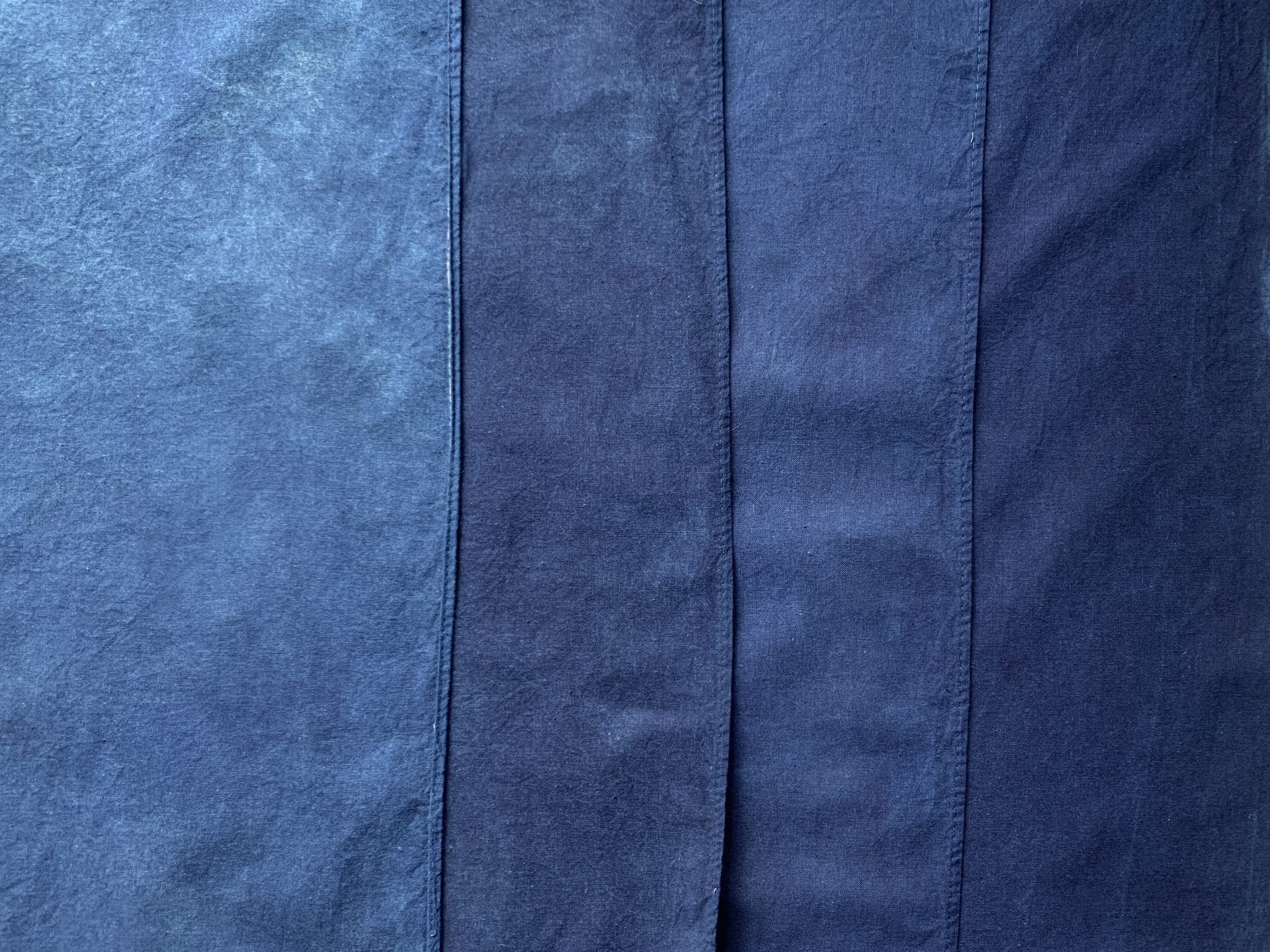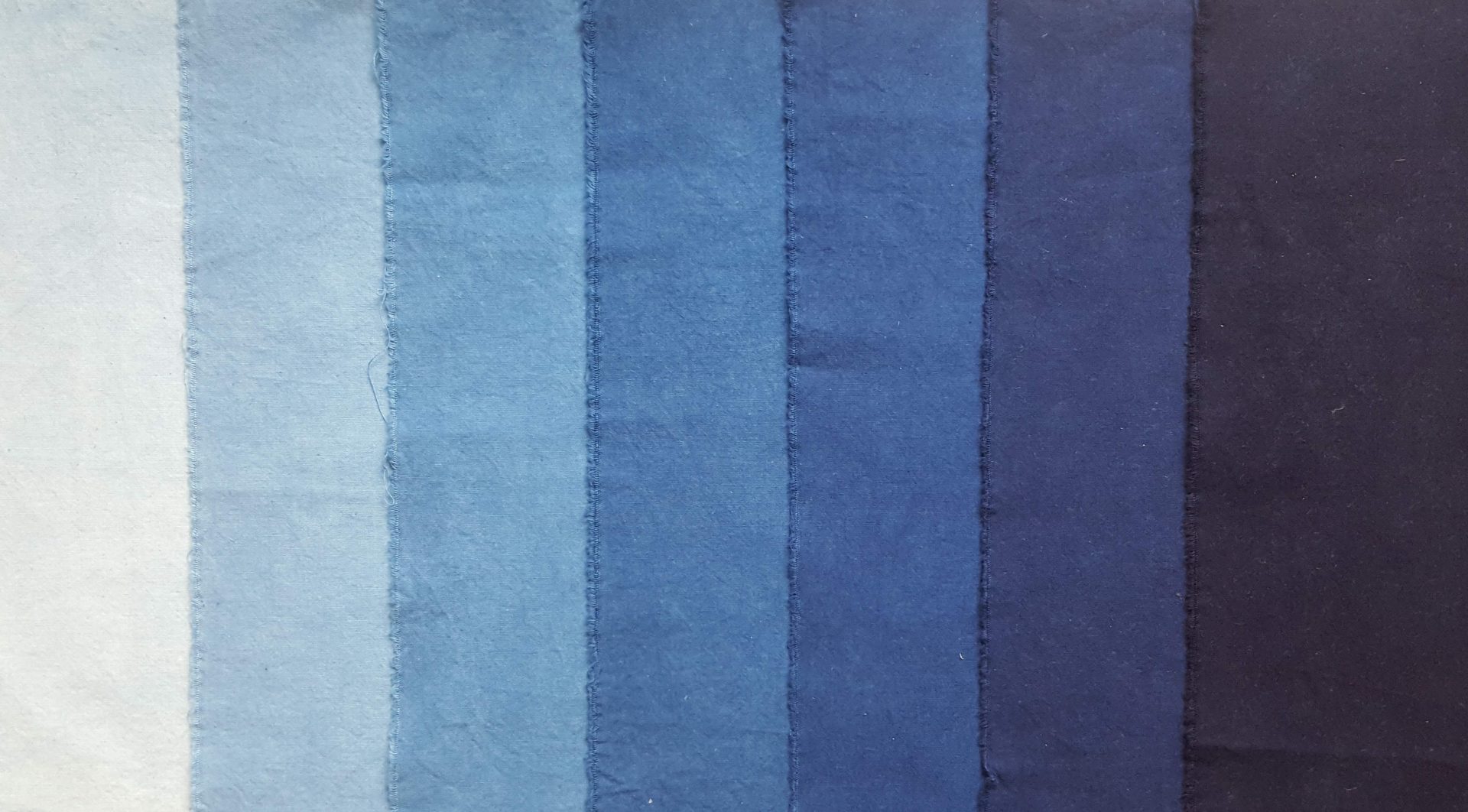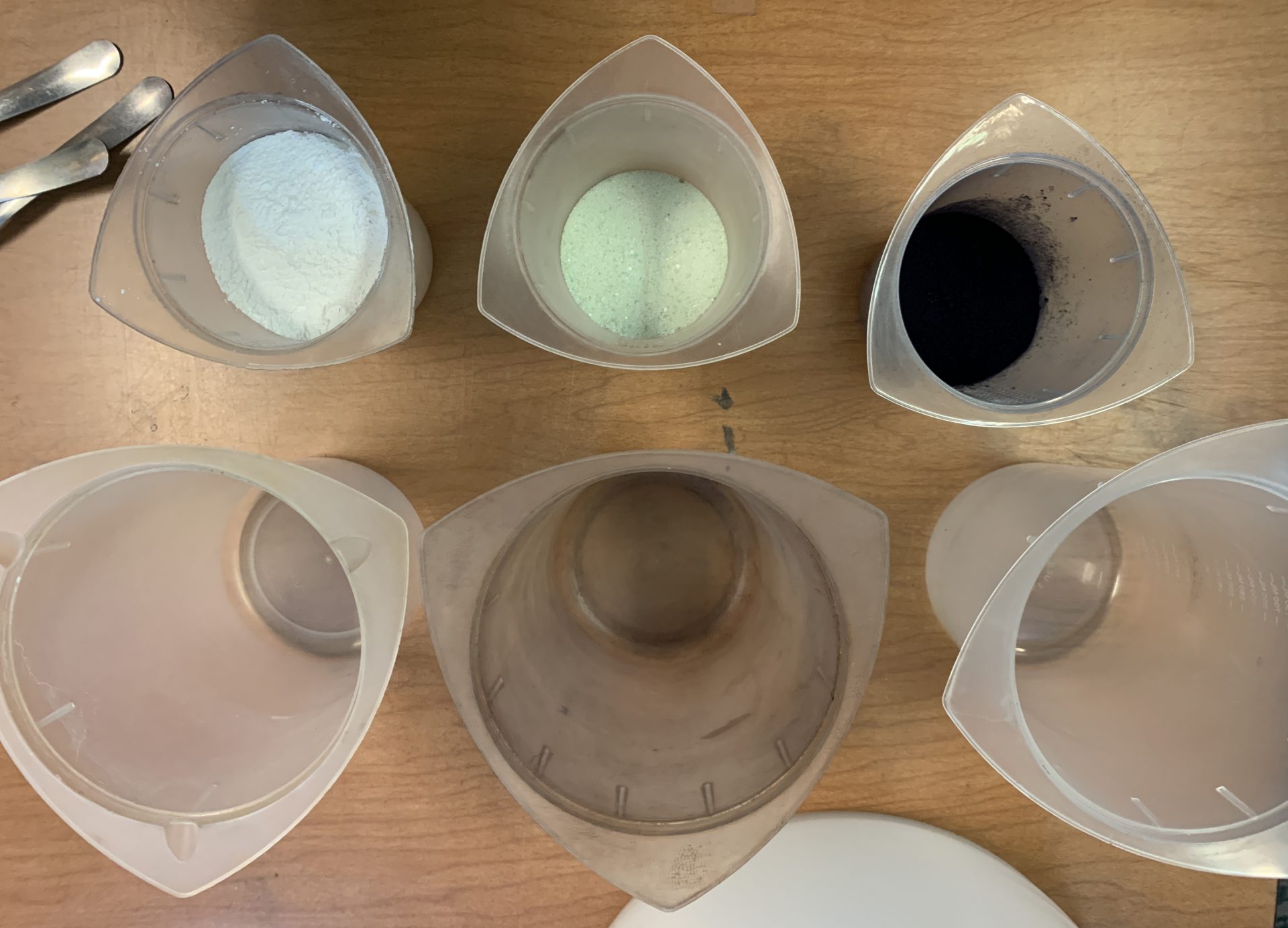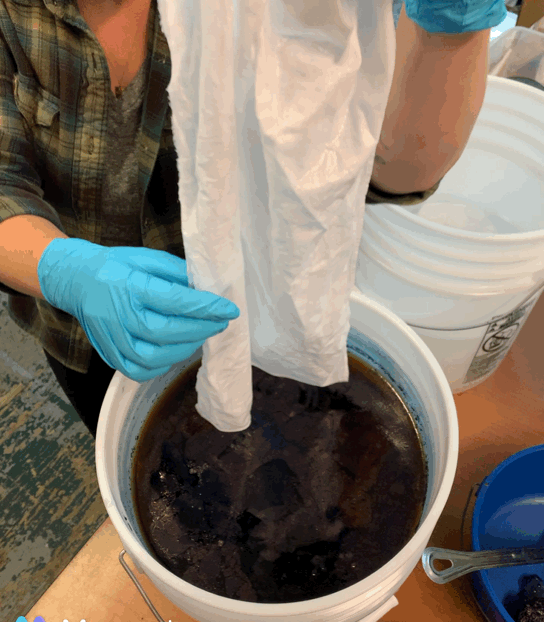An iron vat will give you a cool blue-gray color. It is a good choice for dark blue shades. Once it is built, you can dip in this vat at room temperature without reheating it. If you want to dye wool or silk, do not use an iron vat as it damages protein fibers.
Important safety note: Iron (ferrous sulfate) in high doses is unsafe for babies, small children and pets. It is not known if iron residue remains on the fabric and in the vat in amounts that could be of concern. Out of an abundance of caution, we recommend using this vat for adults only. Store iron in a secure location and away from children and pets.
Unsure about what type of vat you want to use? See our blog post about different vat types here!

Getting Started
Ingredients (Amounts are calculated below)
- Powdered natural indigo
- Calcium Hydroxide
- Iron powder
- Very hot water at 175-180F (80-90C)
Equipment
- A container to build your vat in with a lid. A 5 gallon bucket works well and is a good choice for experiments.
- Check the temperature tolerance of the container that you choose. Make sure it is heat rated to 212F (100C). Otherwise, the container may sag or collapse with heat.
- A scale that can measure grams
- Three containers (approx. 1 quart or 1 liter size) to dissolve ingredients.
- Spoons for each ingredient
- A wooden dowel or broomstick to stir your vat
- Drying rack or clothing rack to hang your pieces
- Water source
- Drop cloths or tarps to protect your space
- A shallow tray to catch drips (optional)
- Bucket heater (optional, follow manufacturer’s instructions if using)
Safety
In addition to iron powder, we are working with fine powders and a dust mask is highly recommended. Calcium hydroxide is basic and may be irritating. Gloves and eye protection are also useful to protect eyes and skin. The temperature of the vat water is very hot – nearly 180F (90C) – so use pot holders when heating water for the vat and watch for spills and steam. If using indigo around children, adult supervision is highly recommended. The vat liquid is alkaline and may be drying or irritating to skin.
Studio Setup
- Get comfortable. Create a work area that is a good height for the indigo vat, so you aren’t unnecessarily stooping or reaching. You can either dip standing up (using a table or countertop), or sitting (using a sturdy low bench or cinder blocks to put your indigo vat bucket on).
- Protect any work surfaces with tarps or drop cloths.
- Set up a space to hang your wet pieces after dipping them in the vat. Use a drying rack or clothing rack to hang them on and place a small tray beneath it to catch any drips. You can return the liquid you collect in this tray back to your vat.
- Wear an apron and gloves to protect your clothing.
How to calculate your ingredients
First, you must decide what shade of blue you want to dye with your vat. We refer to light, medium, and dark indigo vats as a way to talk about the amount of indigo in each vat and how much and how dark a vat will dip. However, since indigo dyeing involves layering multiple dips on a piece to build up the color, it’s possible to dye something a dark blue in a light indigo vat, but it will take more dips in the vat and more time to build up the color. It is difficult to dye a light blue in a dark vat as the fiber is not in the vat long enough for the indigo to strongly attach and the light shade may streak, fade or wash out.
- The amount of indigo in a vat is expressed as grams of indigo per liter of liquid in the vat, or gpL.
- Calculate the amount of liquid that your vat container can hold, leaving room for you to dip textiles into the vat without crowding or touching the sediment layer at the bottom of the vat. Our example is using a 5 gallon bucket, which is approximately 19 liters. However, since we need enough room to add fibers without overflowing the bucket, we will make a vat of 4.2 gallons, or 16 liters.
- Use these gpL guidelines based on what shade of blue you want to achieve.
- Once you know the amount of indigo you want to use in your vat, you can calculate the other ingredients based off of this gpL number.
These amounts are for natural indigo powder, not for fresh indigo leaves, sukumo or instant indigo. If you have made your own indigo pigment, you can experiment to see how much makes a light, medium or dark vat.

How much indigo to use in your vat in gpL
- For a light to medium vat, use between 2.0 and 2.5 grams of indigo per liter of vat liquid
- For a medium-dark vat, use 3 to 6 grams of indigo per liter of vat liquid
- For a dark vat, use 7 to 10 grams of indigo per liter of vat liquid
How to calculate the amount of indigo, iron, and calcium hydroxide in the vat
An iron vat is built with one part indigo, two parts iron, and three parts calcium hydroxide. Sample measurements are below.
| Desired shade of blue | Water | Indigo gpL | Indigo in grams | Iron | Calcium Hydroxide |
| Light | 16L | 2 grams per liter | 32g | 64g | 96g |
| Medium | 16L | 5 grams per liter | 80g | 160g | 240g |
| Medium-dark | 16L | 6.25 grams per liter | 100g | 200g | 300g |
| Dark | 16L | 8 grams per liter | 128g | 256g | 384g |
As an example, let’s say we want to create a fairly dark vat in a 5 gallon bucket with 7 grams of indigo per liter of water (7gpL). Our measurements would be:
- Indigo: 16 liters x 7 grams of indigo (for a dark vat) = 112 grams of indigo
- Iron: 16 liters x 14 grams of iron = 224 grams (double the amount of indigo)
- Calcium hydroxide: 16 liters x 21 grams of calcium hydroxide = 336 grams (triple the amount of indigo)
Creating larger vats
A 16 liter (4.2 gallons) vat is a great vat to start with for dipping small items or to run experiments. However, if you want a larger vat, this recipe can be doubled, tripled, or scaled up as needed. You simply need to determine the liters that your vat can hold and calculate the numbers based on the amount of indigo you want to be in your vat based on a light, medium or dark value. The additional ingredients are then calculated in a 1:2:3 ratio.
Setting the vat
These instructions are for a 16 liter vat, which fits well in a 5 gallon bucket. We used 50g indigo, 100g iron and 150g calcium hydroxide to make a medium vat.
- Heat 16 liters of water to 180 degrees F/80 degrees C.
- Add 14 liters of hot water to your vat bucket.
- Use the remaining two liters to dissolve all the ingredients.
- Wet out 50 g of indigo and dissolve. Add this to your vat and use some water to rinse your tools and make sure you get all of the indigo into the vat.
- Hydrate and dissolve 100 g iron. Add the iron into your vat and use some more water to rinse your tools.
- Hydrate and dissolve 150 g calcium hydroxide.You can spoon the calcium hydroxide in your your water gently as it has a tendency to puff up. Add this to your vat and use some more water to rinse your tools.
- If you have any water left from the two liters, add it to the vat.
- Stir the vat well with a wooden broomstick or dowel for about three minutes. A cluster of bubbles called an indigo flower will form. Slowly pull the broomstick out of the vat when you’re done stirring.
- Let the vat rest, at least until the water is cool enough to comfortably dip in. The vat will get stronger if you let it rest for two to three days.

The liquid in your vat will look very murky at first. As your vat rests, the indigo flower will rest on top and the surface of the vat will have a copper-y sheen to it. Below this top layer, the liquid of your vat should be a translucent purple to amber color. If your vat liquid is cloudy and looks like miso soup, stir it well again and let it settle. As your vat rests, the vat liquid will change from a purple-reddish color to a yellow-green color.

Using your vat
Before dipping
Soak your clean, scoured textiles in lukewarm to hot water for at least 20 minutes. Take care with wool fibers to avoid felting.
Your vat will be ready to use as soon as it’s cool enough for you to comfortably dip in it and the indigo liquid is clear. However, you can also save your vat for later use. The strength of the vat will deepen after it sits for a couple of days, as the indigo benefits from curing.
How to dip
Indigo dyeing works by building up color with multiple dips in a vat, allowing the textile to oxidize and rest in between each dip. When you dip a textile in the vat and remove it, the textile will first have a greenish color, then turn to blue as it interacts with oxygen in the air and the indigo bonds to the fibers. This process is called oxidation.
If you have a layer of foam or cluster of bubbles on the top of your vat (called a flower), carefully remove it, setting it aside to return to the vat at the end of dipping. Take your textile out of the water it’s soaking in and slowly and carefully lower it into your vat.
Once the textile is fully submerged, use your hands to gently open any folds or creases and ensure that the entirety of the piece is exposed to the vat liquid. If you’re dyeing an article of clothing, open up the arms or legs, make sure that pockets or flaps of fabric are fully opened, and check the hems to ensure that they aren’t folded over on themselves. Do not let the fabric or yarn float to the surface and also keep the textile from touching the sediment layer at the bottom of the vat.

Keep the piece submerged in the vat for one minute, gently moving the textile through the liquid, then slowly remove it from the vat. Carefully wring it out over the vat to keep as much indigo in the vat as possible. The piece will be greenish-yellow when you remove it from the vat and slowly turn blue once it’s in the open air. Open the textile and shake out any folds. Hang the textile or fiber and allow it to fully turn blue. Once there is no more green or yellow left on the piece, you can repeat the dipping process as many times as needed to build up darker shades of blue. Be sure to dip your piece in the vat at least twice to stabilize and even out the indigo color, even if you are trying to create light blue shades. Keep in mind that once you rinse and dry the textiles, it will be one or two shades lighter than it appears at this stage, so dip one shade beyond what you want the final color to be.
Tip: You can vary the dipping time from 1 minute to several minutes per dip, but always build up to darker shades with multiple dips. It is very difficult to get good, lasting color with a single short dip for light blue, or a single long dip for dark blue.
Washing and finishing the textiles
Let your textiles air out until they are completely blue, with no yellow or green areas. This means that the indigo has fully oxidized. Rinse the textile until the water runs clear. You can also wash the textile with a mild pH neutral soap. Take care not to handle wool fibers roughly. For the final rinse, use one capful of household distilled vinegar in the final rinse water and soak the textile for 20 minutes, then rinse. Hang to dry away from direct sun.
Balancing your vat
If your vat isn’t a clear yellow or amber color after you stir it and let it settle, you may need to balance the vat. First, try heating your vat, stirring it well, and letting it settle for at least 20 minutes. All of the sediment at the bottom of your vat will be reincorporated and may balance the vat. Use a piece of scrap fabric to do a test dip of one minute and see the strength of your vat. If the vat liquid color is dark blue, you will need to reduce it. Add more iron, one tablespoon at a time. Stir well, let it settle and see if the color of the vat reverts to a clear yellow or amber shade. Check our blog for more hints and tips on balancing the indigo vat.
Waking up a vat
To wake up the vat after it has been dormant for 24 hours or more, heat the vat again to 90-120F (32-49 C). You can do this with a bucket heater or place the bucket in a water bath. Stir your vat with a broomstick or wooden dowel well and let it settle for 20 minutes. Check the liquid – it should be clear. Then your vat will be ready to dye and you can dip a test strip of fabric to check the strength of your vat.
Adding indigo to a vat
If you want to keep your vat going after many dips and observe that the vat is getting weaker, you can add more ingredients to the vat. You will need to calculate and measure the ingredients, using the same calculation of 1:2:3 proportions of ingredients. Dissolve them in very hot water, then add them to your existing vat. Make sure the amount of liquid you are adding to your vat doesn’t cause it overflow. Stir well and let the vat settle, then test the strength of the vat with a piece of scrap fabric.
Storing and disposing of a vat
Once you are finished dyeing for the day, return the flower to the vat, stir well and cover the vat tightly. You can keep it at room temperature but don’t let it freeze. Once the vat is stored, it can keep indefinitely.
To dispose of the vat, add ½ to 1 cup of white vinegar and stir well to neutralize the indigo liquid. Let the vat settle, then carefully pour the liquid down the drain. The sediment that will be at the bottom of your vat can go in the trash. It is full of calcium, so could also be used in the garden if you want to balance acidic soil. Your tools can be washed with soap and water.
